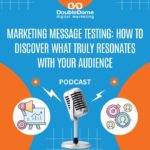By admin

Struggling to get your messaging to land with your audience? It’s not always about spending more—it’s about speaking clearly. Marketing message testing is the method smart teams use to figure out what language, tone, and value propositions actually move the needle. In this episode, we’ll dive into how testing your message can drive conversions, reduce wasted spend, and help you connect better.
Key Takeaways
-
What to Test First
Start with impactful elements like headlines, value propositions, CTAs, tone (e.g. conversational vs. formal), and how you frame the problem vs. solution. These typically yield the biggest insights early. -
How to Structure the Test
Define a hypothesis (e.g. “Will ‘Save Time’ convert better than ‘Boost Productivity’?”), segment your audience so you can see which messages work for which groups, choose metrics that reflect real business value (leads, conversions, not just clicks), run tests long enough to see stable patterns, and scale what works. -
Where to Run Message Tests
Try A/B tests in your paid ads, landing pages, and email campaigns. These touchpoints give fast feedback and allow you to compare performance across different message versions. -
What Happens Post-Test
Once you identify a message that resonates, roll it out more broadly. Use it in metadata (SEO), ad copy, campaign headings, and place it where your audience sees it most. Keep testing so you don’t stagnate.
Final Thoughts
Marketing message testing isn’t a “nice to have”—it’s essential for conversion growth. When you stop guessing and start validating, every part of your funnel becomes more effective: better ad performance, more engagement, and more qualified leads.
Ready to Message with Confidence?
Begin your marketing message testing today: pick a high-traffic page or campaign, run a test on your headline or CTA, measure what really matters, and adopt what wins. Want help designing the right tests or interpreting results? Let’s work together to fine-tune your messaging and maximize impact.








